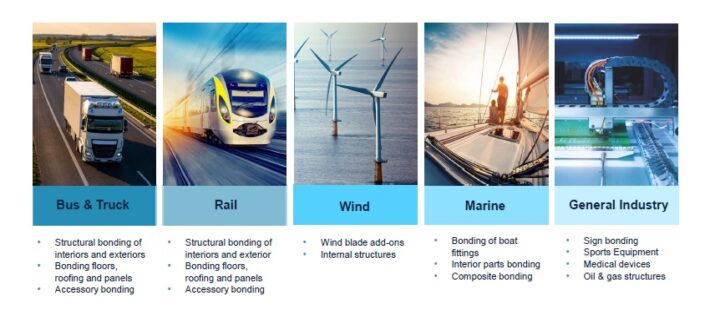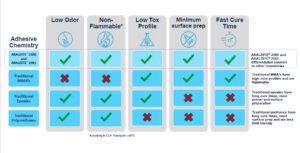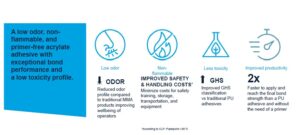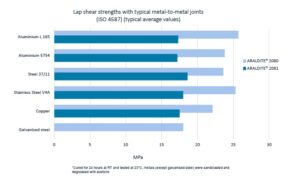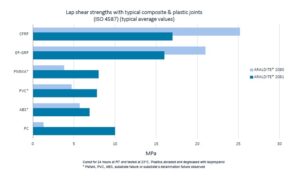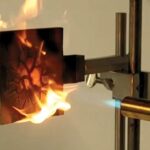Alexander Weis, Strategic Marketing Manager Adhesives EMEA, Huntsman Advanced Materials
ARALDITE® 2080 and ARALDITE® 2081 – low odor, non-flammable, and primer-free acrylate adhesives with exceptional bond performance and a low toxicity profile
The main innovation behind our new ARALDITE® 2080 and ARALDITE® 2081 acrylate adhesives technology is that we have developed a though structural adhesives without technical compromise, but at the same time enable positive sustainability aspects.
Unlike traditional methyl-methacrylate-based products, our new ARALDITE® adhesives are not classified as flammable – according to CLP: Flashpoint >95°C – which leads to lower usage costs and environmental impact by reducing the need for specialized safety training, and special storage and transportation conditions. Additionally, since the new acrylic technology is not subject to several transportation restrictions such as road transport in tunnels, CO2 emissions are reduced by optimizing delivery routes.
The new adhesives also have an improved GHS classification; they are not corrosive, and the “signal wording” changes from “Danger” to “Warning.” Operators are exposed to fewer hazards, which allows them to manipulate the products with fewer constraints due to less uncomfortable PPE equipment. These benefits also show up in the odour profile of the new products, which is up to 90% less odour than MMA products, making it a safer and more pleasant working environment for users.
As a final benefit, the ARALDITE® 2080 and ARALDITE® 2081 adhesives require limited surface preparation in most applications, they provide exceptional bonding performance on multiple substrates (plastics, composites, and metal), and fast efficient curing at room temperature.

Sustainability “built-in” – ARALDITE® 2080 and ARALDITE® 2081 help companies to achieve their own sustainability goals
ARALDITE® 2080 and ARALDITE® 2081 adhesives drive productivity and support lowering CO2 emissions. In addition, they help companies to reduce costs with none of the compromises often associated with traditional adhesives, such as high odour, flammability, toxicity profiles, and the need for surface preparation and heat- or post-curing.

Versatile and flexible for many different applications
We currently have two different technical grades available on the market: ARALDITE® 2080 designed for bonding composites (GRP & CFRP) and metals (aluminium + steel) and ARALDITE® 2081 designed for bonding engineered plastics (PMMA, PVC, PC, ABS).
Due to this versatility, we cover a wide range of bonding substrates enabling multiple applications in various industries to create long-lasting bonds, that will have as one of its main characteristics a high impact and crash resistance with 50%+ elongation performance. Additionally, bond lines with ARALDITE® 2080 and ARALDITE® 2081 display a strong cataplasma resistance of > 12 MPA (measured after 7 days), a maximum continuous operating temperature of 90°C (Araldite® 2080) and 70°C (Araldite® 2081), as well as high tensile strengths of > 25 MPA (Araldite® 2080) and > 17 MPA (Araldite® 2081) and a modulus of 1.200 MPA (Araldite® 2080) and 800 MPA (Araldite® 2081). Lap shear strength testing data for various metallic, composite, and plastic substrates can be found in the charts below as a reference for exemplary bonding applications.

Key industries for ARALDITE® 2080 and ARALDITE® 2081 adhesives
The benefits described for our new adhesives have the biggest positive impact on bonding applications within the transportation Industries for the manufacturing of Buses, Trucks & Trailers, Railway, and for Marine applications.
In addition, we also see potential in general industrial applications where bonding tasks range from trims, profiles, and fixtures, all the way to plastic part bonding in consumer electronics and small and mid-sized home appliances.

More innovation on the horizon for Huntsman Advanced Materials
Our innovations and technology teams are currently focusing their efforts on further developments and improvements, with the aim of making our ARALDITE® low odour, low toxicity adhesives more efficient and accessible on a global scale.
In addition, we are developing concepts to reduce plastic waste for our adhesive packaging, work on solutions for debonding on demand to enable repairing and recycling, are starting to utilize bio-attributed raw-materials in our plants and want to enable viable ways for the recycling of carbon-fibre composite materials. All these activities are clearly in line with our strategy to replace old inefficient materials with new modern materials, to enable our customers to achieve their own sustainability targets.


